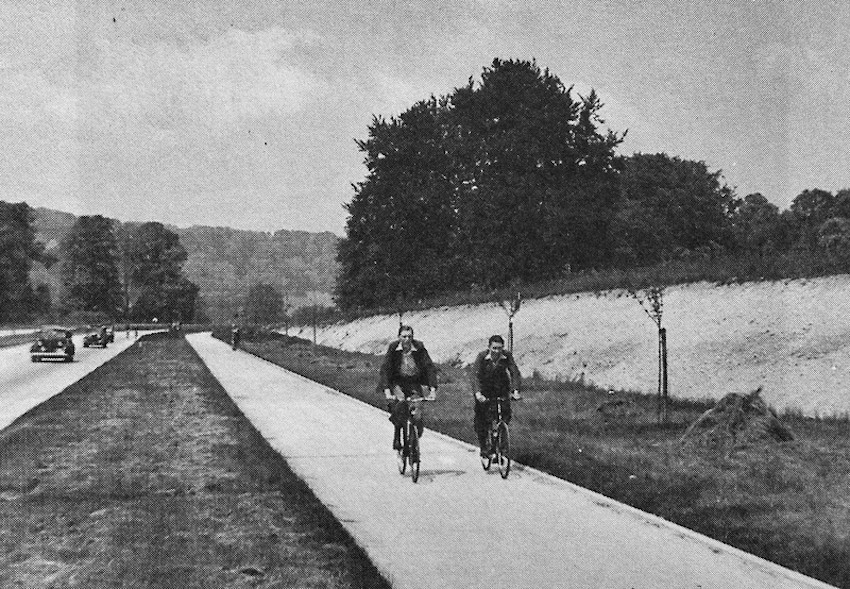In the 1930s, the U.K. built a massive network of state-of-the-art bike trails. Now the challenge is to revive them.

Imagine having a 300-mile network of segregated, long-distance bike lanes that provided an alternative to a highway system. In the U.K., it’s not just an urbanist’s daydream—it already exists, but everyone forgot about it.
The nation is currently rediscovering its large-scale grid of bike lanes, built across the country in the 1930s and still substantially in place, if largely neglected over the years. The old lanes are now at the heart of a crowdfunding campaign, one designed to promote these lanes’ rehabilitation as part of Britain’s contemporary cycling infrastructure. What makes the find all the more remarkable is that the network was essentially rediscovered by accident.
The lanes came to light while transit historian Carlton Reid was doing research for his recent book Bike Boom. Reading up on the Dutch Ministry of Transport’s early forays into bike infrastructure, Reid discovered that the Dutch had in fact advised Britain’s transport ministry in the 1930s on the creation of its own cycle network. Some of these lanes were already known in cycling advocate circles—one well-known example was opened in West London in 1934 by Britain’s transport minister Leslie Hore-Belisha. Elsewhere, their sheer extent had been forgotten.
From our partners:
In fact, as Reid discovered, Britain went through something of a cycle lane boom in the late 1930s. Between 1937 and 1940, Britain’s government demanded that any state-funded scheme to build an arterial road must also include a 9-foot-wide cycle track running the length of the road. Just as surprising as the government’s enlightened attitude is how cycling groups responded: with deep suspicion.
“At the time, the feeling among cycling groups was, ‘We deserve our place on the road. We don’t want to be relegated to a secondary system,’” says John Dales, an engineer working with Carlton Reid on the campaign. By contrast, Dales says, government thinking on the issue sounds strikingly modern. “Immediately after the war, the Ministry of Transport published a road design guide for built-up areas that insisted that ‘segregation should be the keynote of modern design.’” As a reflection of this attitude, the bike routes’ construction was taken quite seriously. They were solidly built, with broad 9-foot-wide concrete surfaces often rimmed with granite curbs.
This enlightened official approach chimed with the times. Cycling was still a vital means of transit in a country where car ownership only became common in the late 1950s. Many of the new, broader roads that would ultimately take the burden of Britain’s car boom were still being planned and constructed between the wars. The cycle network grew up as part of this new road network, rather than by scraping existing lane space away from motor vehicles. It thus avoided the controversies that cluster around such projects today.
Still, if these routes had been heavily used, we’d probably have known more about them. Contemporary references to the network are scant, but it’s possible that actual usage was light because the lanes sprung up along new roads and in newly laid-out districts where traffic was still pretty low. They may have been laid out to plan for future demand rather than to cater to needs that already existed. Wartime priorities saw an end to the cycle lane growth spurt and, once the austerity of Britain’s immediate postwar years started clearing toward the close of the 1940s, bike use dropped off sharply.
Many of the routes nonetheless remain in place. They’re just not expressly marked as bike lanes and have faded into usage as roadside pathways or parking, or have been grassed over. To date, Reid and Dales have discovered more than 90 protected bike lane plans (mapped below) covering more than 300 miles. It’s possible—indeed likely, given the considerable scope of British 1930s road building—that there are still more out there waiting to be rediscovered. Clearly there are plenty of people keen to know exactly what else is out there. The crowdfunding campaign has already exceeded its modest £7,000 initial target threefold, with still almost a week before it closes.
The money will fund further investigations locating neglected bikeways, and the project will then approach local authorities to discuss ways to reopen them and mesh them with existing infrastructure. There’s admittedly a large jump between this step and the reopening of a full national network, but the project could still score major victories for cycling advocates. Uncovering and reusing these old tracks could prove far cheaper than constructing new lanes. The network provides a readymade answer to claims that there isn’t enough space for bike highways between towns. And it makes clear that, if Britain managed to find money to produce state of the art bike lanes during the Great Depression, it can definitely do so again.
This feature originally appeared in Citylab.
















